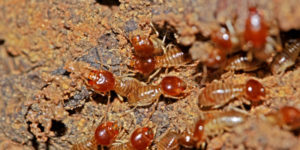Termites can leave a trail of destruction behind them as they slowly, but surely eat your home day after day, without you even knowing they are there. Because of their aversion to light, termites stay hidden as they eat the cellulose out of the boards in your walls, roof, and floor so knowing how to identify if you have a termite problem is crucial to keeping your home from becoming termite food. Knowing what to look for and where to look will help you to discover a termite problem early before they have a chance to do much damage.
Keeping termites out
Keeping your home well maintained is an excellent way to protect your biggest asset, your home, and to keep it safe from extensive termite damage. Being sure to fix broken windows, roof damage, and any damaged exterior walls promptly will help keep moisture out of your home. Termites need a source of water to thrive and if you have a drip or leak somewhere in your house, termites will soon identify your property as their ideal spot to start a new colony.
In addition to keeping water out of your home, keep soil, mulch, shrubs, and leaf litter below the foundation of the house and at least 12 inches away from the house. Termites need to get close to the foundation in order to enter it and they sometimes need a little time to search for an entry point. Keeping all organic matter away from the house will not give termites a chance to find a way into your home.
Signs of a termite infestation
Seeing termites spilling out of the walls is certainly not an experience you want to have. After a termite infestation has grown over the months and years, they will send out swarmer termites, which have wings, to find a home for a new colony. Catching a termite infestation well before this point will ensure that there is less damage and that the infestation is not so widespread. Signs to look for are:
- Shed wings on outdoor window sills
- Hollow sounding trim or wooden furniture
- Warped or water damaged looking floors
- Piles of sawdust below window frames, furnitures, or under wall hangings
- Mud tunnels on or around the foundation of the home
Call a termite pro
If you discover evidence of termites, do not hesitate to call a pest control pro to inspect, identify, and eliminate the termite infestation quickly and thoroughly. A termite queen can lay up to 2000 eggs a day and live for over a decade. Waiting a week before calling a professional termite exterminator could mean that 14,000 new eggs have hatched and any number of adult termites have continued eating away at the structure of your home. A termite control pro has the equipment and experience to eliminate the termite infestation.
After the infestation has been eradicated, continue to at least have a yearly inspection by the pest pro you hired to make sure that the termites never infest your home again. If you are in La Jolla, CA, and want to hire the best termite exterminating team, give Nixtermite a call today.



